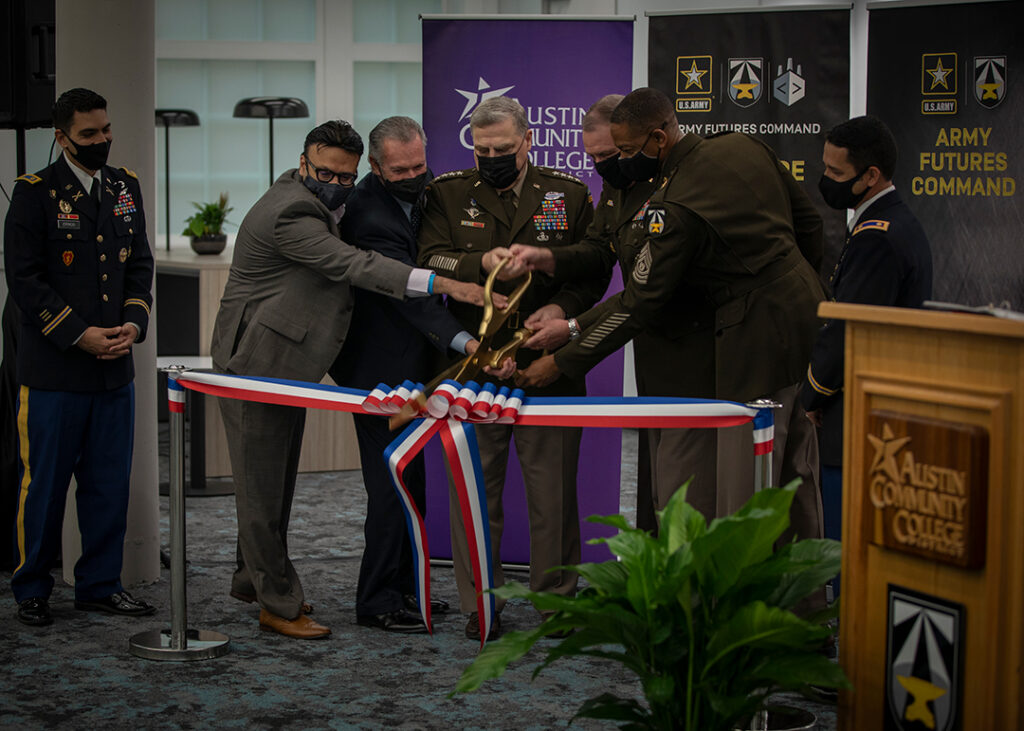THE WATCH STAFF
The military command with a mission to modernize the U.S. Army has launched a webpage to call attention to its achievements.
The online 2021 Year in Review from the U.S. Army Futures Command (AFC) provides an interactive snapshot of its modernization accomplishments in the past year, which included staging Project Convergence 2021, the largest joint-force experiment in 15 years, according to a January 24, 2022, AFC news release.
The AFC’s achievements also included opening the Army Software Factory and making breakthroughs in COVID-19 vaccine research.
(Pictured: The chairman of the U.S. Joint Chiefs of Staff, Gen. Mark A. Milley, center, participates in a ribbon-cutting ceremony April 15, 2021, for the Army Software Factory in Austin, Texas. The facility is part of Army Futures Command.)
“We couldn’t be prouder of the work put forth by our team members this past year,” Lt. Gen. James Richardson, the acting commander of the AFC, said in the news release.
“The combined expertise of our incredible researchers, scientists, engineers, academic and industry partners, Army civilians and Soldiers continues to ensure that the Army will be ready for whatever the future holds,” he said.
For the Project Convergence experiment, the Army focused on its Integrated Battle Command System (IBCS), which will be its contribution to the Joint All Domain Command and Control (JADC2).
JADC2 is the Department of Defense concept to connect battlefield sensors from all of the services — Air Force, Army, Marine Corps, Navy, and Space Force — into a single network, enabling a speedier transfer of data, information, intelligence and communications, according to a March 18, 2021, report from the Congressional Research Service (CRS). Traditionally, each military service developed its own tactical network that was incompatible with those of other services, according to CRS.
“Up until today, all the services, for years, decades, have been developing their own internal systems,” Gen. Mark Milley, chairman of the Joint Chiefs of Staff, said in March 2021, according to the website Defense One.
“But we don’t fight wars as an Army, a Navy. … We fight wars as a nation, and we fight wars with allies and partners.”
Northrop Grumman, the IBCS manufacturer, said that Project Convergence proved the system — which was cleared for production in 2021 — can remotely detect and defeat threats using ground, air and space sensors, according to a January 19, 2022, Defense News story. The IBCS was also able to pass ground-target tracking data to a fire-control system, according to Defense News, helping the Army connect with what the military describes as “every sensor with every shooter.”
The AFC, headquartered in Austin, Texas, said its 2021 efforts will help put 24 new systems in the hands of Soldiers by fiscal year 2023, according to the news release.
Speaking to the Washington Post newspaper on April 12, 2021, Gen. James McConville, the U.S. Army chief of staff, said such systems are crucial as the reaction times for Soldiers and commanders continue to shrink in the modern battlespace.
“When you take a look at the systems that we’re developing … the speed of the systems that we need, the range of the systems we need. And this concept of convergence, where we bring together the sensors and shooters,” McConville said. “We can provide lethal effects in tens of seconds [instead of] tens of minutes.”
IMAGE CREDIT: LUKE J. ALLEN/U.S. ARMY

